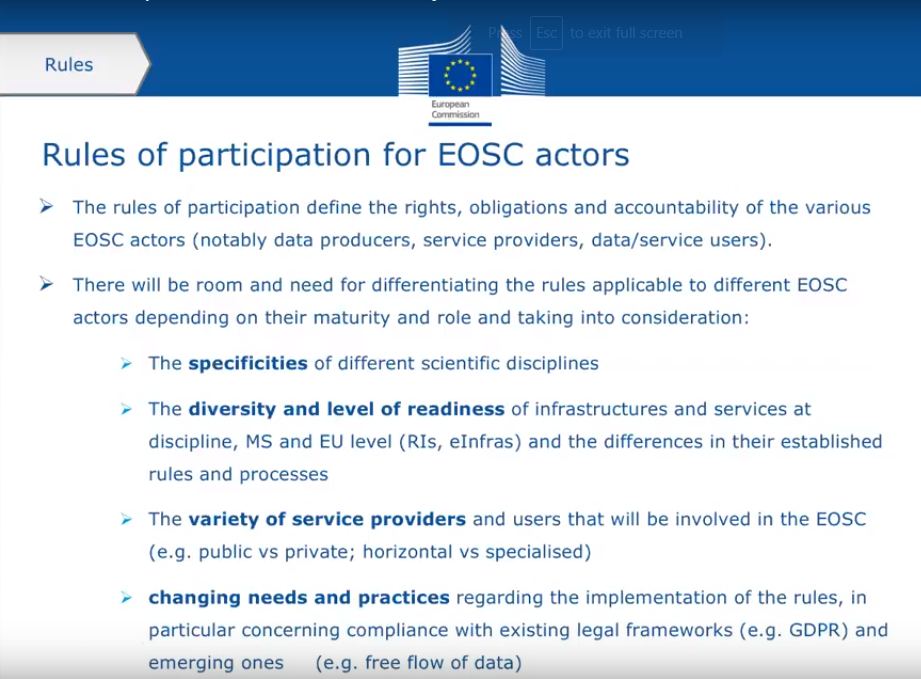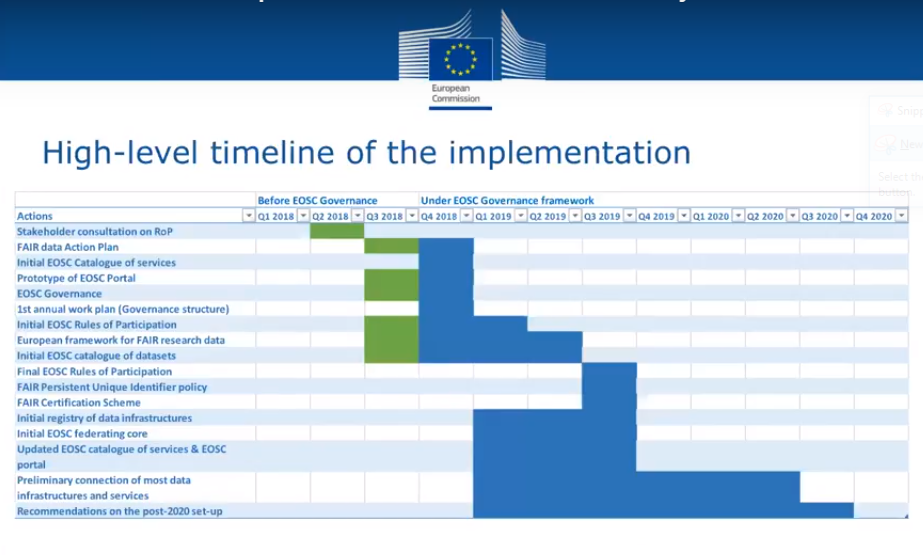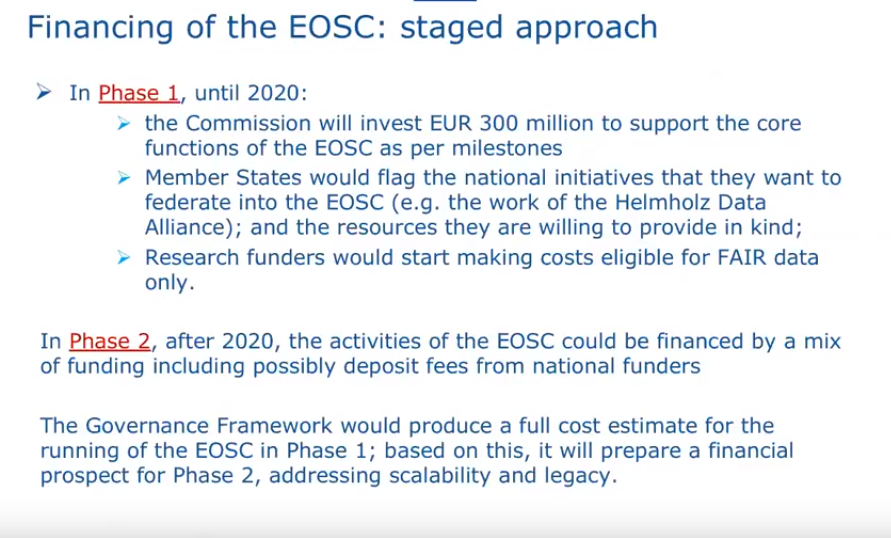
9 Points from the 9th EOSC Governance Forum that show our Future EOSC
Fresh from the publication of the Implementation Roadmap for the European Open Science Cloud (EOSC) Staff Working Document mid-March, the 9th EOSC Governance Development Forum was held last 17 May, highlighting a clearer picture of what the EOSC would look like in the future.
The EOSCpilot Project organises the EOSC Governance Development Forum on an almost monthly basis. The latest has revealed the main building blocks that will make up the EOSC by 2020 and beyond.
This latest forum was themed, “Translating the vision into practice - The European Open Science Cloud Roadmap” was a clear reference to the recently published Staff Working Document that touched on topics such as EOSC governance structure, rules of participation, sustainability, and more.
Main speakers during the forum, delivered through a webinar, were European Commission Research and Innovation Directorate-General Policy Officers Athanasios Karalopoulos and Katarzyna Szkuta and opened by EOSCpilot’s Governance Work Package Leader Per Öster.
If you’ve missed the last webinar, don’t worry, as we’ve got you covered. Here are the main points from the webinar:
1. EOSC will be a federation
Six action lines cover architecture, data, services, access and interface, rules and governance. In architecture-wise the open science cloud is envisioned to be a federation, instead of a centralised system.
All nodes or points, from various research data infrastructures, that will be federated are expected to commit to provide services and will provide their data sets as part of this environment according to a compliance framework. This framework will be presented through the Rules of Participation (see below).
“This federation process will not happen just in months but gradually, on a voluntary basis. Let’s say for example a research infrastructure will be connected to the EOSC, deciding to offer a number of services and datasets to the EOSC environment, the commitments and the federation will concern only that part of the infrastructure that will be opened to the EOSC environment. The rest will be free to follow their own commitments outside the EOSC.”
- Karalopoulos
However, before this gradual process begins, a set of simple, best practice-based guidelines will be published.
2. Two-pronged approach for FAIR data
With the EOSC being a federation that will connect independent research infrastructures, it is necessary to adopt FAIR (findable, accessible, interoperable and reusable) data principles that will allow datasets shared across the EOSC to be properly utilised by the people who need them the most. To achieve this, the adoption of FAIR data principles in EOSC will have to be done on two fronts – from a technical standpoint as well as a cultural one.
A FAIR Data Expert Group was set up to provide recommendations before the end of 2018 on how different disciplines can implement FAIR data principles and a FAIR data action plan was prepared which identifies actions to be taken to be able to promote the implementation of the FAIR data principles.

At the same time, a study on FAIR data is also being made which will highlight the costs of not having FAIR research data, the costs and benefits of having FAIR research data and policy recommendations.
This will contribute to the FAIR data activities in 2019 where they expect to come up with a FAIR Data Work Plan and a FAIR Data Maturity Model that will later be vital to establishing FAIR data accreditation or certification schemes and the EU Framework for FAIR Data.
3. Five future EOSC services named
Karalopoulos presented five services that are expected to be offered over the open science cloud:
- Identification and authentication
- Protected and personalised workspace
- Access to relevant information and specific guidelines
- Finding, accessing, storing, re-using and analysing data
- Services to for FAIR-ifying own data
He explained that all thematic calls and discipline-specific calls as well as national-specific infrastructures provide very mature services.
“Here you can see the five types of services that are more or less provided by the majority of European research infrastructures. The vision is for researchers to be able to find and use these same five services via the EOSC as well”.
- Karalopoulos
4. EOSC accessible through multiple points
In keeping with its non-centralised structure, the EOSC won’t just be accessible through one single access point but through the infrastructures that are part of the EOSC.
What we described in the Staff Working Document is not to have a universal entry point only but to give the users the choice between different entry points.
- Szkuta
Every research infrastructure that will be a node in the EOSC cloud can offer a user interface and front end to their users where they will have access to the services offered by EOSC. This front end will be connected to an EOSC backend that will offer access to all the shares resources of EOSC. This allows the research infrastructure to carry on their own services while still being a gateway to the EOSC services.
In a way, the concept of the interface should make it user-focused as the users are not forced to access the EOSC services on another portal but can do so from their own.
At the same time, there will also be an EOSC portal which would be the universal entry point for all potential users without a thematic or national focus but cross disciplinary with pan national focus.
We will have a full-fledged user interface. Irrespective of location or affiliation, users can access it. This work is being built by EOSC-hub and eInfraCental and other projects supported by H2020 projects and it will be further developed in the next course of H2020.
- Szkuta
5. Rules of Participation will be stakeholder-based and won’t be fixed

To be able to federate infrastructures or nodes, the EOSC Rules of Participation will have to be drawn up. Stakeholders will play an important role in defining the rights and obligations and accountability of the EOSC actors.
What we mean by actors isn’t just infrastructures but also service providers that can join the EOSC and provide commercial and non-commercial services. We also consider researchers, data producers and the users that will be using the data as EOSC actors.
- Szkuta
She added that the Rules of Participation is expected to take into consideration the specificity of the different scientific disciplines, the diversity and maturity of infrastructures and their services in the member states and discipline level, the variety of service providers and users that will be involved and both public and publicly-funded and commercial private entities.
However, even when finally laid down, the EOSC Rules of Participation aren’t expected to have a long-term horizon.
We want them to change depending on compliance with new or emerging rules that will come
- Szkuta
The first draft of the Rules of Participation will be opened for comments from stakeholders which will help create a finalised set of rules by 2019.
6. Staged approach for implementing EOSC governance
Two phases will characterise the development of the open science cloud’s governance. The 1st Phase (until 2020) will boost the creation of the EOSC. The 2nd Phase (2021 onwards) will build on the experience of the 1st phase.
The 1st phase governance structure is expected to have a light mechanism, higher accountability with low intervention cost. The European Commission and the member states will play a leading role with the participation of stakeholders and consultants advising the EC and the member states.

As it moves to the 2nd phase, the EOSC governance will still be led by the member states and the Commission but with the stakeholders playing a bigger role. The proposal for the 2nd phase governance will be included in the Framework Programme 9 proposal and will be subject to council conclusions and the decision of the member states.
Here are some of the key blocks in the EOSC governance structure:
- EOSC Board: Member states and European Commission providing a political lead.
- Executive Board: From stakeholders and will translate the high-level vision of the EOSC Board
- Working Groups: Established by the Executive Board on an ad-hoc basis and from stakeholders working on different aspects of the EOSC strategy
- Stakeholder Forum: Made of stakeholders that will provide input to EOSC Board and Working Groups
- Coordination Structure: To be set up through INFRAEOSC-05-2018-2019: Support to the EOSC Governance to support the Executive Board and the Working Groups
Want to understand the EOSC governance better? Check out the original EOSC governance structure proposed by EOSCpilot which has many similar elements incorporated in the new governance structure depicted above.
7. Rules of Participation consultation, Governance & Catalogue of Services coming out before 2018’s end

During the upcoming EOSC Summit in June 2018, the commission is expected to launch its consultation on its draft EOSC Rules of Participation.
Work on the Fair Data Action Plan, the prototype of the EOSC Portal and EOSC Governance will start next month in June and is expected to be delivered by the end of the year. Meanwhile, the initial Catalogue of Services will also be launched by the end of 2018.
With the establishment of the EOSC Governance, the 1st annual workplan will be produced.
8. Financing evolution: from heavy public funding to a sustainable business model
Similar to the evolution of the governance structure, EOSC’s financing structure will also evolve to a two-stage approach from a mix of heavily EC-funded initiatives towards a more sustainable business model. In the first phase, which is already ongoing, the European Commission has already allotted €300 million for the Horizon 2020 Work Plan to support the EOSC calls.
On the national level, the member states are building and upgrading their own national infrastructures and are deciding what part of their national systems would be part of the EOSC. There are also research funders that are expected to cover the cost of making data FAIR.
However, as EOSC moves towards the second phase, there will be a shift with a focus towards more sustainability.
In Phase 2, there has to be a business case for EOSC and it has to be a business model which allows it to be sustainable in the long-term. That will be decided by the governance framework at the end of Phase 1, so at the end of 2020 we should have a final plan for EOSC on how to scale it and build legacy.
- Szkuta

9. Strong policy push paves the way for EOSC implementation
At the end of the first quarter this year, the European Commission produced its Staff Working Document, the Implementation Roadmap for the European Open Science Cloud. The end of the second quarter of 2018 will see the European Council conclusion endorsing the EOSC Implementation Roadmap.
In fall this year, the governance structure and its official launch, which includes the designation of representatives from the Member States to the EOSC Board as well as members of the governance structure will be done along with the governance structure being agreed on by Member States during the Austrian Presidency event in November.
“At the end of phase one in 2020, Member States and the European Commission, building on the advice from stakeholders, will agree on the future strategic orientation and financing scheme for the EOSC,” added Szkuta.
